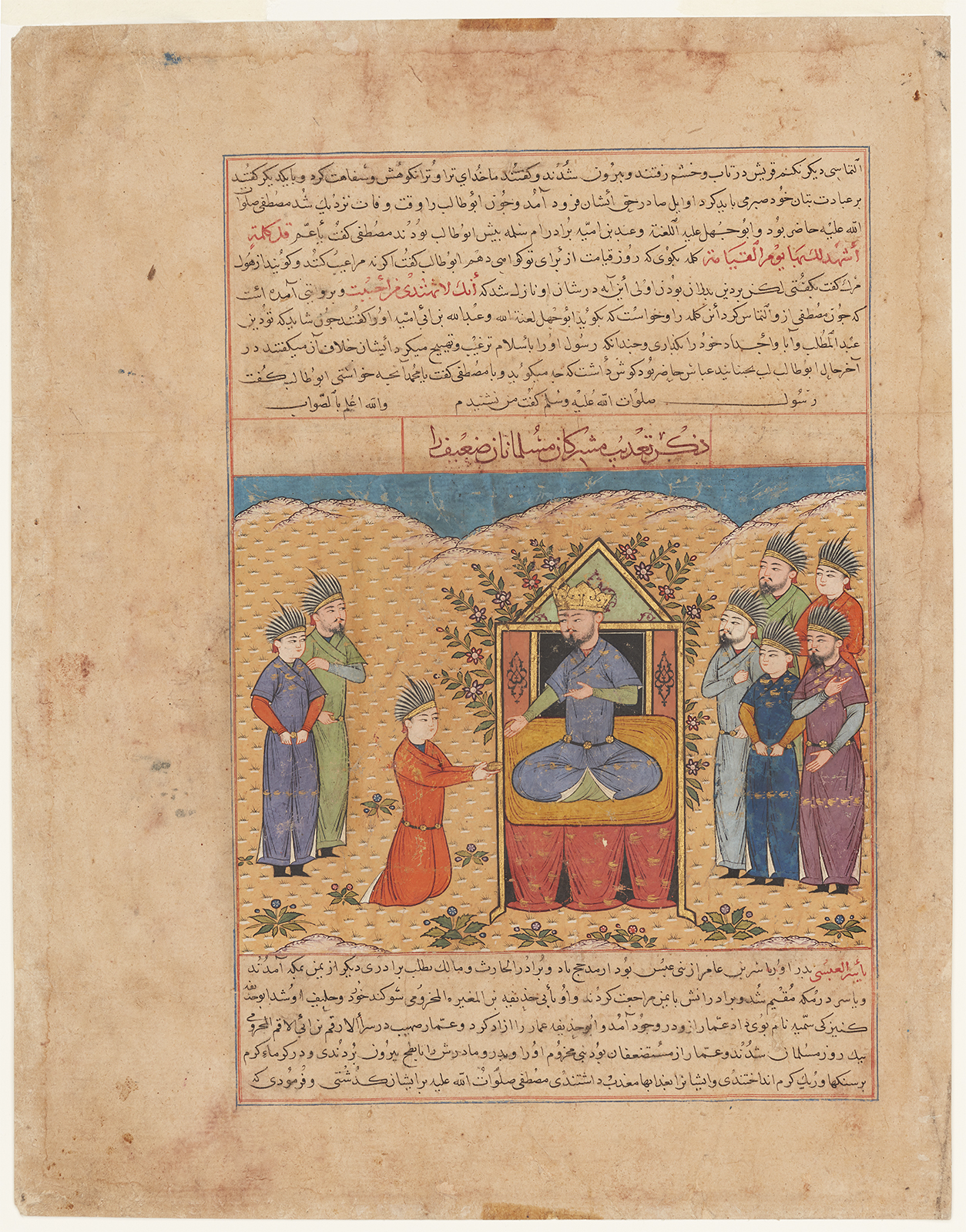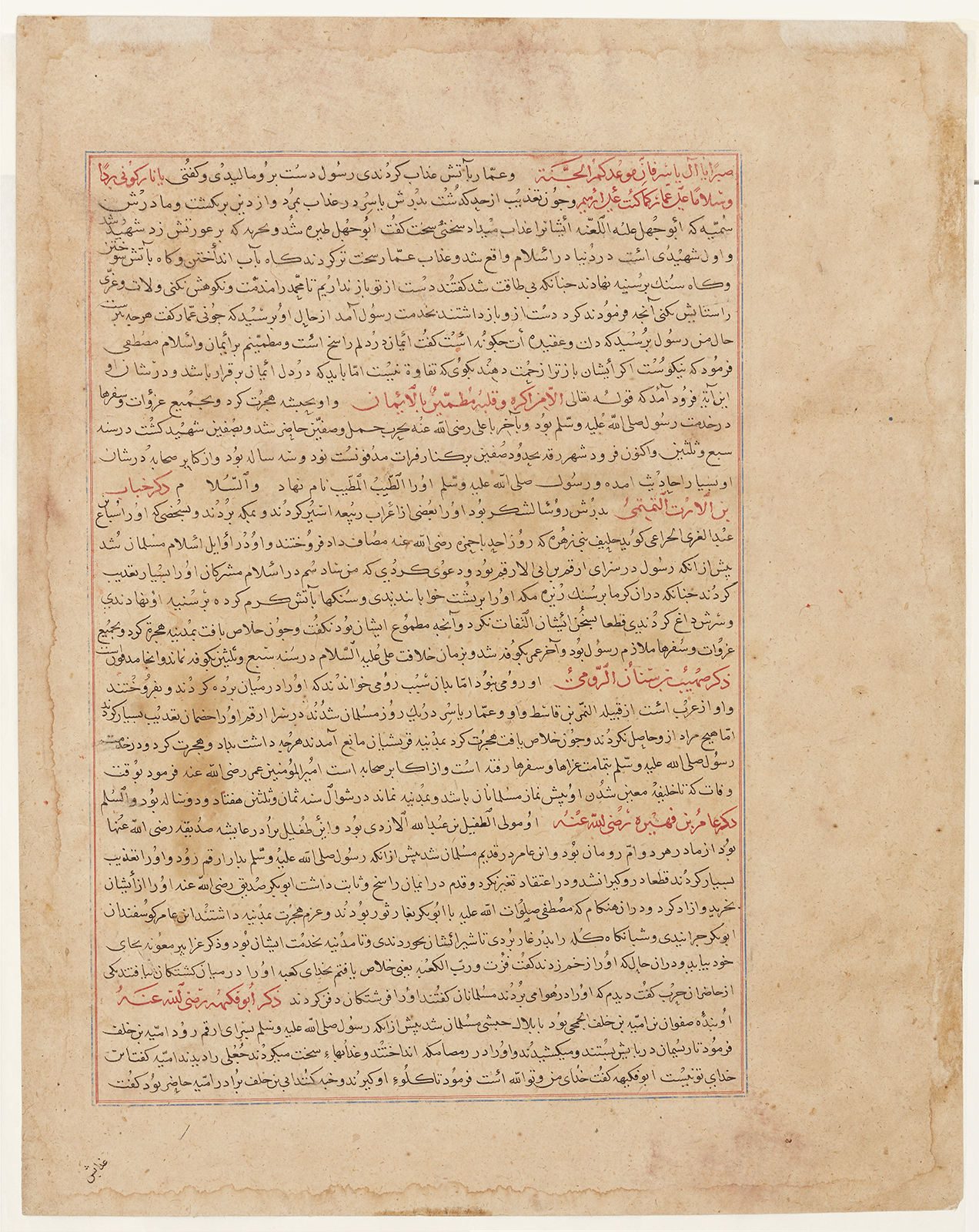Click on the image to zoom
Concerning the punishment of an idolator (one of the weak Muslims)
- Accession Number:AKM41
- Place:Iran, Herat
- Dimensions:42.8 x 22.5 cm
- Date:early 15th century
- Materials and Technique:ink, watercolour, and gold pigment on paper
This folio, along with two others in the Aga Khan Museum Collection (AKM89 and AKM40), comes from a manuscript assembled at the court of Shahrukh (d. 1447) and disassembled by the art dealer Émile Tabbagh in the 1920s and 30s. The manuscript’s content draws primarily from a world history prepared by Rashid al-Din (d. 1318) for the Mongol Ilkhan Oljeitu in 1307. It is not a simple copy of Rashid al-Din’s work, but rather a hybrid manuscript with a tangled history made even more complex by its dispersal. This folio reveals one of the abiding mysteries of the manuscript: here, similar to a group of other dispersed folios, an illustration appears in place of a block of missing text.
Further Reading
The world history that Rashid al-Din presented to Oljeitu became the second volume of his famous historical compendium, the Jamiʿ al-Tavarikh (see AKM517 for an important copy of the first volume, containing a dynastic history of the Mongols). This world history consisted of an account of the pre-Islamic past assembled from Iranian, Jewish, and Greco-Roman traditions, followed by a history of Muhammad and the Sunni caliphate through the fall of the Abbasids in 1258 and various dynastic histories of local Islamic dynasties of Iran: the Ghaznavids, Saljuqs, Khwarazmshahs, Salghurids, and Ismaʿilis. These sections were in turn followed by a series of five summary histories of other peoples from across Eurasia: the Oghuz Turks, Chinese, Jews, Franks, and Indians. In its original state, the manuscript from which this folio was taken largely followed Rashid al-Din’s original format, though the history of the Jews has been omitted.[1] Also, most of Rashid al-Din’s history of the pre-Islamic period has been replaced by another version composed by Hafiz-i Abru, court historian to Shahrukh, in the 1420s. This folio comes from near the beginning of the history of Muhammad.
Rashid al-Din’s world history was assembled from various sources, many identifiable. On the whole, it contributes little original historical information. One of the most notable features of the work for modern scholars is the place it holds in the history of Persian book painting. The Ilkhanid period witnessed significant innovations in the arts of the book. Illustrated volumes were used first to educate the new Mongol rulers in the traditions of the Islamic world and later to demonstrate their command of resources from across Eurasia. Rashid al-Din’s world history was a perfect vehicle for such a display and was elaborately illustrated with figures and scenes reminiscent of the artistic traditions of Europe and China. The work helped set a new standard for elite manuscript patronage in the Perso-Mongol world, inspiring later illustrated historical manuscripts such as the one from which this folio was taken.
In its original form, this manuscript was very heavily illustrated, with at least 150 of its approximately 470 folios containing paintings. Many of these images match the location and type of illustrations found in other 14th- and 15th-century copies of Rashid al-Din’s work. However, additional illustrations have been added to the manuscript that have no comparanda in other copies. Some of these, like the illustration on AKM89, have been added to blank spaces in the manuscript. Others, such as this image, appear in place of large blocks of text.
In comparing this folio to Rashid al-Din’s text, it is clear that approximately half a page of Rashid al-Din’s text is missing here. Close examination of other folios where such gaps occur reveals no sign that any text was ever written in this space. In other words, the page was originally formatted to hold an image at the expense of text. Naturally, this approach breaks up the narrative of the book, but increases its visual appeal. It can only be concluded that this manuscript was created for display, and not to be read.
— Stefan Kamola
Notes
[1] Art and History Trust ms. 22, fol. 208 contains the end of the history of China and the beginning of the history of the Franks, showing that the history of the Jews has been omitted. Nothing has survived of the history of the Salghurids, so that section may have been left out of the original manuscript as well. However, in its original form, the history of the Salghurids would have only covered about three folios. A portion of the manuscript is unaccounted for that includes the last three folios of the history of the Khwarazmshahs and the first four folios of the history of the Ismaʿilis. It is therefore impossible to know whether the Salghurid history was omitted or if it has been lost along with its surrounding folios.
References
Ettinghausen, Richard. "An illuminated manuscript of Hāfiẓ-i abrū in Istanbul. Part I." Kunst Des Orients 2 (1955): 30-44.
Ghiasian, Mohamad Reza. “The ‘historical style’ of painting for Shahrukh and its revival in the dispersed manuscript of Majmaʿ al-Tawarikh,” Iranian Studies 48.6 (2015): 871–903.
---. Lives of the Prophets: the Illustrations to Hafiz-i Abru’s “Assembly of Chronicles.” Leiden: Brill, 2018. ISBN: 9789004377226.
Martinovitch, Nicholas N. “Die verlorene Handschrift von Rašīd ad-Dīn,” Artibus Asiae 5.2/4 (1935): 213–21.
Rashid al-Din Fadl Allah al-Hamadani. Tarikh-e Iran va Islam, ed. Muhammad Raushan. Tehran: Miras-i Maktub, 2013.
Soudavar, Abolala. Art of the Persian Courts: Selections from the Art and History Trust Collection. New York: Random House, 1992.
Tauer, Felix. “Les manuscrits persans historiques des bibliothèques de Stamboul, Ire partie,” Archiv Orientální 3.1 (1931): 87–118. ISSN: 0044-8699
Welch, Anthony. Collection of Islamic Art, Vol. I. Geneva: Château de Bellerive, 1972.
Note: This online resource is reviewed and updated on an ongoing basis. We are committed to improving this information and will revise and update knowledge about this object as it becomes available.




